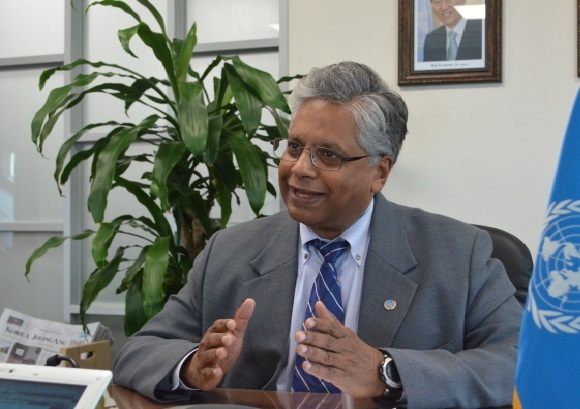Since the financial crisis in 2008, we have been witnessing marked changes to the global economic landscape. One such change, within Asia and the Pacific, is the recognition of the need to find new growth engines beyond the strategy of exporting to developed markets.
As this year’s Economic and Social Survey of Asia and the Pacific highlights, the solution to invigorating the region’s growth lays in enhancing regional cooperation and connectivity, by allowing ease of access to a greater pool of resources and markets, and by ushering in the development of low-income countries. Considering two-thirds of the world’s poor live in the Asia-Pacific region and the gap in the region between advanced economies and the least developed is the largest in the world, poverty eradication alone can exponentially broaden the consumer base and unlock regional demand. In addition to growth concerns, greater cooperation is also needed to address emerging challenges, such as rapidly shifting population dynamics and energy security.
With 2014 projected to be yet another year of tepid growth aggravated by political tension and uncertainty, Asia and the Pacific and particularly East and Northeast Asian economies are called on to step up to the plate and assume greater responsibility for revitalizing dynamism in the region.
As this year’s Economic and Social Survey of Asia and the Pacific highlights, the solution to invigorating the region’s growth lays in enhancing regional cooperation and connectivity, by allowing ease of access to a greater pool of resources and markets, and by ushering in the development of low-income countries. Considering two-thirds of the world’s poor live in the Asia-Pacific region and the gap in the region between advanced economies and the least developed is the largest in the world, poverty eradication alone can exponentially broaden the consumer base and unlock regional demand. In addition to growth concerns, greater cooperation is also needed to address emerging challenges, such as rapidly shifting population dynamics and energy security.
With 2014 projected to be yet another year of tepid growth aggravated by political tension and uncertainty, Asia and the Pacific and particularly East and Northeast Asian economies are called on to step up to the plate and assume greater responsibility for revitalizing dynamism in the region.

Certainly, the timing is ripe for East and Northeast Asia to take on a greater leadership role in propelling the region to the next level of development. Combined, China, the Democratic People’s Republic of Korea, Japan, Mongolia, Republic of Korea and the Russian Federation account for one-quarter of the world’s population and close to a quarter of the world’s GDP and trade. It is home to two of the world’s top three economies and has an abundance of technological, financial, human and natural resources. In other words, the untapped contributions of East and Northeast Asia remain vast. Taking trade as an example, ESCAP’s report finds that, on average, the potential gain is greatest when trading with East and Northeast Asia for all countries in Asia and the Pacific.
However, as the ESCAP Executive Secretary and United Nations Under-Secretary-General Dr. Shamshad Akhtar emphasized during the annual session of the 70th Commission early this month, the Asia-Pacific’s economic dynamism to date had been primarily driven by individual economies, but that future success would depend on the extent to which the countries of the region were able to integrate and cooperate for sustainable development.
Despite the age-old political differences, there have been encouraging initiatives put forward by East and Northeast Asian economies. China’s proposed Asian Infrastructure Investment Bank is expected to help fill the huge infrastructure financing gap in the region that ESCAP estimates to be approximately $800 billion-$900 billion per year. Furthermore, President Xi Jinping has announced the Chinese government’s aspirations to develop the Silk Road Economic Belt, including maritime network development, with the scale and potential to link to the Asia-Pacific rim in the East and to Europe in the West.
In the same vein, the Republic of Korea proposed its “Eurasia Initiative” linking energy and logistics infrastructure across the continent and suggested establishing a “Silk Road Express” connecting rail and road networks from the Republic of Korea to Europe and the development of new sea routes utilizing the Arctic Sea.
The Russian Federation is also doing its part in leading the agenda on energy connectivity and security in the Asia-Pacific region and is working with the two Koreas on infrastructure development. In 2013, the joint venture between DPR Korea and the Russian Federation completed the construction of a modern railway from the Russia/ DPR Korea border to Rason and the reconstruction of one of its piers.
There are many more examples of bilateral and multilateral discussions in East and Northeast Asia that are helping to generate vital momentum for greater regional cooperation and connectivity. Concurrently, it is essential to connect the dots of these individual country efforts toward a more integrated approach to maximize synergy. In this regard, on a subregional level, the annual Northeast Asia Economic Forum held in Seoul this year and co-organized by ESCAP on Aug. 28-29 provides an important platform for Northeast Asian experts and policymakers to gather and openly discuss all of the key aspects of connectivity and integration including transport, energy and finance.
On the regional level, ESCAP, with its intergovernmental mandate, will continue to work with member countries to build consensus and encourage policymaking for regional cooperation and integration.
By Kilaparti Ramakrishna
Kilaparti Ramakrishna is the head of the United Nations Economic and Social Commission for Asia and the Pacific’s East and Northeast Asia Office — Ed.



![[Herald Interview] 'Amid aging population, Korea to invite more young professionals from overseas'](http://res.heraldm.com/phpwas/restmb_idxmake.php?idx=644&simg=/content/image/2024/04/24/20240424050844_0.jpg&u=20240424200058)















![[Today’s K-pop] Kep1er to disband after 2 1/2 years: report](http://res.heraldm.com/phpwas/restmb_idxmake.php?idx=642&simg=/content/image/2024/04/25/20240425050792_0.jpg&u=)